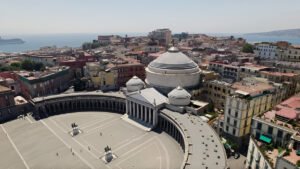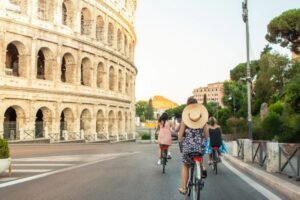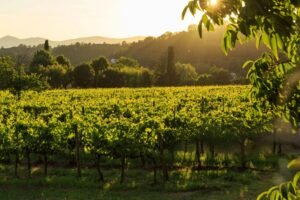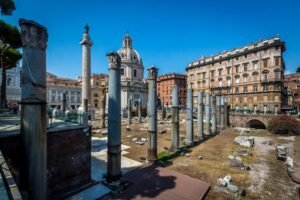Best waterfall in Italy | Explore the top picks
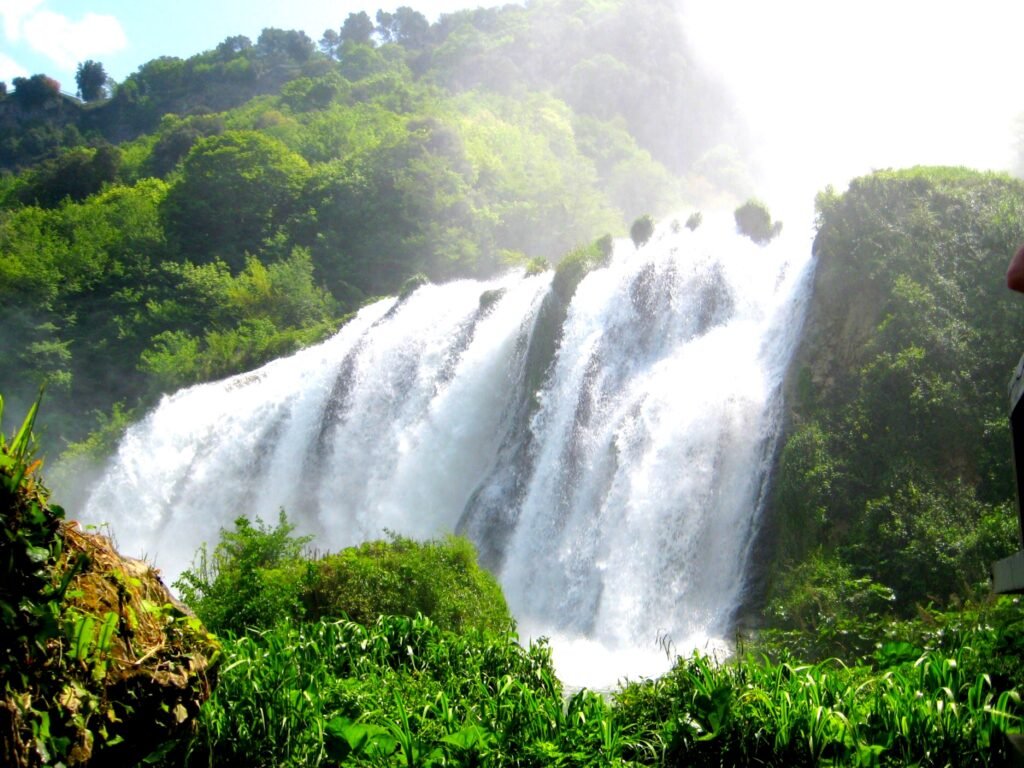
The Stroppia Waterfall is widely regarded as the best waterfall in Italy, offering an awe-inspiring natural spectacle. It is found in the upper Maira Valley. This great waterfall is being cascaded in three drops, amounting to a total height of 500 m. It is by far the highest, most powerful, and best waterfall in Italy to get.
Late spring is the time to travel here: you’ll find the rush of water from the melting snow unbelievable, an experience worth repetition. The hike along the Dino Icardi trail not only brings you to this natural wonder, but also provides generous views of the valley. Stroppia Waterfall, if not above all, is a must-see If you’re seeking the best waterfall in Italy with adventure, relaxation, and beautiful views.
Cascata delle Marmore (Marmore Waterfall)
Location: Terni, Umbria
Best For: Families, hiking, and photography.
The tallest man-made waterfall is located in the Umbria region of Italy. The waterfall pours down over three sections from 541 feet above, making it one of the tallest waterfalls, natural or man-made, in the country.
This waterfall runs on a schedule that is published for tourists and the local electric power plant. Most tourists try to come when the waterfall’s flow is first turned on to witness the first burst of water. The Cascata delle Marmore dates back to 271 BC, when the Roman consul Manius Curius Dentatus commissioned it.
The construction of a canal was initiated to drain the stagnant waters of the Rieti Valley wetland, which were fed by the Velino River. In 1787, an architect was hired by Pope Pius VI to perfect the design. He added three sections to the waterfall, including pools that are seen today. This addition drastically reduced the problem of flooding.
Beginning in the late 19th and early 20th centuries, steel mills and electric plants began to utilize the waterfall to generate power. Today, the Piediluco Lake, located above the Cascata delle Marmore, is used as an electric plant reservoir.
Because of this, the waterfall has only a small amount of water flowing most of the time. To attract tourists, the Galleto power plant allows the full force of water to flow over the waterfall at certain times during the day.
Tourists may hike to the top of the falls, where an observation deck provides a view down the waterfall and over the Nera Valley. More adventurous tourists may explore the observation deck next to the falls, where they will get wet from the falling water.
Cascate del Serio (Serio Waterfall)
Location: Valbondione, Lombardy
Best For: Rare and dramatic experiences.
The Cascate del Serio, located near Valbondione in Lombardy’s Bergamo Alps, are the tallest waterfalls in Italy and the second tallest in Europe having a total fall of 315 meters.
That waterfall is really well-known for its impressive height and all the more when water falls down giving a spectacular show. The water flow coming from Bergamo Alps is called as the Serio river; it is falling in three main stages as given below:
- First drop: 166 meters
- Second drop: 74 meters
- Third drop: 75 meters Normally
Those are opened only a few times a year for people to experience the full power of water. The dates planned for 2023 were June 11, July 15 (a night opening), August 20, September 10, and October 8 for this particular year’s openings.
In addition to their natural beauty, the Cascate del Serio have appeared in popular culture. Most notably, the location is where the filming of the 2017 movie “Call Me By Your Name” directed by Luca Guadagnino took place. For some action, people can also visit those falls by trekking from Valbondione with eyes feasted through great views along the way.
Cascata del Toce (Toce Waterfall)
Location: Formazza Valley, Piedmont
Best For: Stunning mountain views and picnics.
Valley Formazza, in the north of Italy, is close to Switzerland and home to the famous Cascata del Toce (The Toce Waterfall). Valley Formazza is an amazingly peaceful Italian valley nestled in the far north of the Piedmont region, close to the Swiss border. The valley hosts multiple hydroelectric power plants from the 1900s, as well as a series of spectacular dams.
The most prominent of these were built by Senator Ettore Conti and designed by the famed architect Piero Portaluppi. The hotel next to La Cascata del Toce also features a classic Piero Portaluppi touch. Formazza is a municipality in the Province of Verbano-Cusio-Ossola, in the Italian region of Piedmont, located about 160 kilometers (99 miles) northeast of Turin and about 50 kilometers (31 miles) north of Verbania, on the border with Switzerland. As of 31 December 2004, it had a population of 443.
The Formazza Valley, an area still characterized by Walser traditions and their culture, boasts top-level facilities and a great skiing tradition. Most of the lift systems are located in Valdo, including the Valdo 1 and Valdo 2 ski lifts, the small Gadostaadt, and the Sagesboden chair lift. Formazza, considered by experts to be the “Queen of cross-country skiing,” hosts two Nordic skiing centers: one in San Michele and the other in Riale.
San Michele offers a 12 km-long run that follows the course of the River Toce to the valley floor. Riale has facilities for Nordic skiing at high altitude (1760 m), surrounded by unique views of the tracks, which were chosen for the training sessions of the most important national representatives of the team that participated in the Torino 2006 Winter Olympics.
In Ponte, there is a ski lift for nocturnal skiing, while on the Sidel Glacier (3000 m), it is also possible to ski in summer, and the nearby 3A Refuge hosts the Summer Ski School. Ski touring is another attraction offered by the Formazza Valley, with numerous itineraries designed to explore the peaks bordering Switzerland.
Cascate di Riva (Reinbach Falls)
Location: Campo Tures, South Tyrol
Best For: Nature lovers and adventure seekers.
Dear travelers, today we will take you to the Riva Waterfalls. The Rio di Riva waterfalls are located in the Vedrette di Ries-Aurina Nature Park and offer an impressive view of nature. Above all, in the summer, fed by melted snow, the Rio di Riva plunges in three cascades over the rock cliffs into the depths, allowing visitors to experience the power of water with all their senses.
If you are coming from the south, like us, from Verona, Trento, or Bolzano, take the motorway and exit at Brixen. Then take the national road toward Puster Valley, turning left into the Ahrntal Valley (Valle Aurina), Sand in Taufers (Campo Tures). Park your car in the center of the village or near the swimming pool.
To reach the first waterfall, it’s an approximately 20-minute walk with a 40-meter altitude difference and is suitable for baby strollers. To reach the second waterfall, it’s about a 40-minute walk with a 140-meter altitude difference. The hike to the third waterfall takes approximately 55 minutes with a 170-meter altitude difference. From here, you can return using the Fly-Line.
Nestled within the picturesque landscapes of Italy, the Riva Waterfalls stand as a breathtaking testament to the raw beauty of nature. Cascading down rugged cliffs with unbridled force, these falls create a mesmerizing spectacle that captivates the senses.
Cascate di Saturnia (Saturnia Waterfalls)
Location: Saturnia, Tuscany
Best For: Relaxation and wellness.
The Mulino Waterfalls are a beautiful thermal complex located near the municipality of Saturnia and are free spas. This means that entrance is open to everyone for free.
The water that flows along the waterfalls has a temperature of about 37 degrees and contains minerals that are beneficial for the skin and the respiratory system. The spa consists of a small waterfall that leads to several natural pools of various sizes, connected to each other by other waterfalls and streams of water.
Now, we come to a small but necessary sore point: the convenient parking 300 meters away, which I recommended in the previous video, is currently closed, contrary to what is written on the website. The parking adjacent to the bar is under construction, and even parking on the sides of the road is not possible due to no-stopping signs and frequent traffic police patrols.
So, at the moment, I cannot advise you to try finding a parking spot a little further away. But after this bad news, let’s move on to the interesting tips I discovered. In fact, what is the best pool in the whole complex? You’ll never imagine which one I’m referring to.
The best pool is, surprisingly, the least visible and most neglected of all—the one behind the mill before the waterfall. There, the water is very deep, and you can stand there safely. For those who are hyperactive and can’t just relax, there are water slides and waterfalls.
But have you ever wondered where all this water comes from? How come you don’t know? Its origin is from aquifers heated by geothermal heat. Yes, thanks, you could have just googled it. What I meant was, where is the source? So, open Maps, start following the watercourse, and you’ll find the Saturnia Spas—the paid ones.
The next day, I decided to visit the paid spas, and I must say,
It was worth it. While they may not be as fascinating as the Mulino Waterfalls, they certainly know how to help you relax. The spas feature enormous swimming pools with water at different temperatures, smaller and super-hot pools, waterfalls, sunbeds, and even a sauna—all for a cost of 27 euros, plus 6 euros for a bathrobe (required if yours isn’t strictly white).
Cascate del Varone (Varone Waterfall)
Location: Near Lake Garda, Trentino
Best For: A unique and atmospheric experience.
The Cascata del Varone is a breathtaking waterfall of northern Italy, located right next to Riva del Garda in the Trentino region. This waterfall’s location About 3 km (1.8 miles) from Riva del Garda, easily accessible by car or bike. makes it stand alone in a mossy gorge surrounded by towering limestones, making it an award-winning natural site for visiting for over 150 years.
The height of the waterfall is around 98 meters (approximately 320 ft), and its water comes from underground springs from Lake Tenno, thus creating a kind of a special geological phenomenon.
Water has worked through numerous rocks over thousands of years to now be left on them, making it a stunning off-course that can be walked along designated paths and seen from viewing points.
Upper Cave: Reach a higher perspective with a panoramic view of the waterfall’s upper section. Lower Cave: Get an up-close view of the cascading water as it gushes through the narrow gorge.
Explore the Botanical Garden, The area around the waterfall is landscaped with a lush garden featuring Mediterranean and alpine plants, creating a tranquil environment.
Hiking and Nearby Attractions, Hike through the surrounding trails to enjoy scenic views of Lake Tenno and the nearby mountains. Visit Lake Garda and the picturesque town of Riva del Garda.
Best Time to Visit, Spring and early summer when water flow is at its peak. Clothing, Wear comfortable shoes for walking and bring a raincoat or waterproof clothing, as the mist can be heavy. accessibility, The site is partially wheelchair accessible, though the upper cave may require navigating stairs.
Cascata di Lillaz (Lillaz Waterfall)
Location: Cogne, Aosta Valley
Best For: Families and casual hikers.
If you like mountains and nature parks and decide to take a nice walk wandering around the Italian Alps, particularly in the Aosta Valley, you absolutely cannot miss the famous waterfalls of Lillaz, which I will describe to you today.
The ice was melting fast on the high peaks of the Aosta Valley, and I was walking in the small village of Lillaz, near Cogne, surrounded by the deep beauty of the Gran Paradiso Nature Park. My goal that day was to visit the beautiful waterfalls that are very famous in this area—probably one of the most important waterfalls in the Aosta Valley.
So, after passing through the small village (where, if you wish, you can stop to eat a hearty meal), meeting this mighty feline, and finding this small geological park, I took the path to the falls. The mule track was wide and flat, and after five minutes, I reached the first waterfall.
Fortunately, it was full of water. Yes, today I was lucky! Sometimes, it can happen that there’s little water, so I recommend visiting this waterfall during the most favorable times—especially in spring, not summer.
Gran Paradiso National Park is an Italian national park located in the Graian Alps between the Aosta Valley and Piedmont. It is named after Mount Gran Paradiso, which stood before me like a wise old snowy wizard—the Dumbledore of the mountains. Sometimes, I contemplated its majesty, hoping for some wise life advice.
I had a mission: to bring you to the most beautiful part of the waterfall—the hidden and most epic fall. After photographing every last drop of water, I wanted to change my perspective. So, I followed a narrow and steep path—definitely not for everyone.
You know, the Lillaz waterfalls are 150 meters tall, so I had to climb a bit to first reach the top of the previous waterfall and then this bridge with a small wooden gate on the right. Of course, I passed through areas of absurd beauty and smaller streams scattered in the forest.
I wanted to go through the wooden gate, but for a couple of minutes, I found myself rather disoriented because there was a sign that said “Private Property.” Would I be badly eaten by a Maremma dog?
But my curiosity was killing me, so I dared, and… well… I was well rewarded, I guess. Three rivulets of water were falling from a height of at least ten meters, and I was stunned by the majestic and unstoppable force being released. I was also thrilled because, you know, I love filming water in slow motion!
The river was clear and very cold, but I met a couple of new friends who were swimming. They were very nice but, in my opinion, completely crazy. Everyone chooses their own way to die, so no probs. As for me, I stopped here for a while to feel the energy of nature and listen to the sound of water, which has this incredible property of making me relax and unwind completely.
Cascate di Stroppia (Stroppia Waterfall)
Location: Acceglio, Piedmont
Best For: Seasonal visits and mountain enthusiasts.
The Stroppia waterfall is located in the upper Maira Valley and originates at an altitude of 2,300 meters at the bottom of the glacial valley of Nasso di Stroppia. With three jumps, it descends a 500-meter wall, making it the highest waterfall in Italy. The best time to visit and admire it in all its splendor is late spring when it reaches its peak beauty.
A sign indicates the start of the Dino Icardi path, where the climb begins. During the summer, when the snow melts, the water level of Neira Lake drops, and the waterfall diminishes, leaving only a strip of dark rock.
From the very beginning, the path rises, winding along the slope through clusters of larches. You eventually arrive almost directly under the waterfall. The roaring sound of the powerful water fills the air, and the wind carries its spray away. The climb continues, and as the path moves away from the waterfall, you reach the Casa’s Ledge—a grassy plain where you can enjoy an incredible view of the valley.
At the base of the bastion, the path crosses two streams, which at this time of year have a strong flow of water. A scenic stretch follows, where the path overcomes the height of the waterfall’s median jump. This section, carved into the rock with hairpin bends, overlooks a steep precipice and is made challenging by the water from the falls, which you have to cross.
The path, built by Alpine troops in 1939, features numerous hairpin bends that ascend a narrow notch and emerge onto a ledge. From there, an equipped route leads to the Stroppia Refuge. The refuge is perched on a small, suspended section of the trail.
A true panoramic balcony offers a magnificent view that stretches from the valley floor to the Provençal Castle Group and the Vallone del Male. Another breathtaking sight includes the jagged spires of the White Rock to the south and the first jump of the waterfall, which you cross as you continue your journey.
Once you pass the Bass of the Donkey, you enter the amphitheater of the Nasso di Stroppia and reach an altitude of 2,302 meters. The Agony side of the waterfall is fed by melting snow and atmospheric precipitation, with a variable water flow depending on the season. In summer, when the water level drops, the outlet is deactivated, and the waterfalls dry up. You’ll have to wait until next spring to once again witness the spectacle of Pescara.
By now, most of the hikers who arrived at the lake have started their descent, and I too have no choice but to begin my journey back. Today, the weather is dark and gray, with the wind rushing through, covering and uncovering the sun. During the descent, at the height of the median jump, the wind suddenly rises.
It pulverizes the water into a fine mist, and the sun illuminates the spray, creating mesmerizing plays of light—a truly stunning spectacle. One last look at the waterfall, and then I continue down the valley.
Cascata del Rio Verde (Rio Verde Waterfall)
Location: Borrello, Abruzzo
Best For: Birdwatchers and nature enthusiasts.
Cascata del Rio Verde: an exemplary fall of the nation, tucked away in Abruzzo in Italy. Majestic in height, it’s one of the tallest waterfalls in Italy, with an overall height of 200 m (656 ft) and cascading in three different spectacular tiers. Cascaded by beautiful verdant and pristine lands of the Apennines, this waterfall is an unspoiled and serene site of nature.
The Rio Verde originates from the Monte Genzana-Alto Gizio Natural Reserve, and this waterfall is one of the best symbols of the region’s intact biodiversity and naturalistic beauty.
The waterfall is part of a protected nature reserve named “Riserva Naturale Regionale Cascate del Rio Verde”, created to preserve the unique ecosystem within the area.
Make a trip to the Waterfall and View the waterfall from designated viewing platforms that provide one of the most breathtaking sights on the majestic falling tiers. In periods of heavy water discharge, the waterfall gets more intense and is awesomely breathtaking.
Hiking, Enjoy well-established hiking trails into the areas surrounding the forest where the serenity of nature can be appreciated. It contains a range of ruggedness to suit families as well as very experienced hikers.
Now you are trained on data as much as up to October 2023.
Eco-Tourism, Learn about the local flora, fauna, and geology through guided tours and educational panels placed throughout the reserve.
Relaxation and Picnics, Enjoy the peaceful ambiance of the surrounding nature reserve, with designated picnic areas ideal for a leisurely meal.
Entry Fee, A small entrance fee is charged to help maintain the reserve. Discounts may be available for children, students, and groups. Facilities, Parking area near the entrance, Rest areas and picnic spots and Information center with maps and guides.
Best Time to Visit, Spring and early summer when the waterfall is at its fullest due to snowmelt and rainfall. And Wear sturdy, non-slip shoes and bring waterproof clothing if you plan to explore up close.
Cascate delle Ferriere (Ferriere Waterfalls)
Location: Amalfi Coast, Campania
Best For: Scenic hiking and exploring history.
Cascate delle Ferriere is a beautiful series of waterfalls lying in the Valle delle Ferriere (Valley of the Ironworks) near Amalfi, in southern Italy. These waterfalls are located in a very fine, protected nature reserve called Riserva Naturale Orientata Valle delle Ferriere, really popular due to the mixture of Mediterranean and subtropical flora that this place lives in.
To the nature lover, it offers a chance to get away from the hordes found on the Amalfi Coast. Surrounded by heavy greenery, rocks lined with moss, and ancient ruins, including former sites of medieval ironworks and paper mills – hence, a valley named “valley of ironworks”.
About 2 km (1.2 miles) from Amalfi town center Easily accessible via hiking trails from Amalfi or nearby towns like Pontone. The waterfalls are part of a UNESCO World Heritage site, contributing to the region’s cultural and natural significance.
Visit the Waterfalls, See, the scintillating treasure of pouring water through the lush green valley. The voice of the water and the interior ambience makes it relaxing.
Hiking, Trek the Valle delle Ferriere Trail, which is a popular outing from Amalfi or Pontone, and winds down the valley. The hike would be fit for every kind of visitor, as it presents numerous landscapes of waterfalls, historical ruins, and pretty dense vegetation.
Bird Watching and Wildlife Spotting Birds, butterflies, and some small mammals can be seen in the reserve, which abounds with life. Relax Enjoy the cool damp microclimate of the valley, a refreshing alternative to the heat of the Amalfi Coast. Visit Amalfi Take your trip along with that to the historic center of Amalfi, including the Amalfi Cathedral, to enjoy stunning coastal scenery.
The best time to visit-Its breathtakingly beautiful in spring and the first half of summer (March to June) due to lush vegetation, flowing waterfalls, and sunny skies. It is best to avoid peak tourist months (July and August) if you are looking for a peaceful experience. Clothing, Use sturdy hiking shoes, and bring a lightweight jacket, like an anorak, because the valley can be slightly cooler and much more humid than surrounding places.
This stroppia waterfall makes it the probably best waterfall in Italy unmatched by any other place concerning natural beauty, adventure, and peace. It has one of the highest 500-meter-high cascades in the upper Maira Valley, making it a destination to visit both for tourists and nature lovers. Whether you come during the late spring to see it in its glory or whether you hike the beautiful Dino Icardi-trail, this waterfall is an experience that you will never forget. Book your trip now and see for yourself why it’s another best waterfall in Italy.
Thank you, and that wraps up our 10 Best waterfall in Italy | Explore the top picks. Do you agree with the places we chose, or is there somewhere you visited that you feel should be on the list? leave us a comment.
You can find me on Instagram: @dreamytravelersofficial/.


